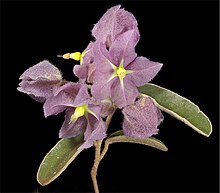| Seringia exastia | |
|---|---|

| |
| In Karijini National Park | |
| Scientific classification | |
| Kingdom: | Plantae |
| Clade: | Tracheophytes |
| Clade: | Angiosperms |
| Clade: | Eudicots |
| Clade: | Rosids |
| Order: | Malvales |
| Family: | Malvaceae |
| Genus: | Seringia |
| Species: | S. exastia |
| Binomial name | |
| Seringia exastia (C.F.Wilkins) C.F.Wilkins & Whitlock | |
| Synonyms | |
|
Keraudrenia exastia C.F.Wilkins | |
Seringia exastia, also known as fringed fire-bush, is a species of flowering plant in the mallow family and is endemic to northern Western Australia. It is an erect, compact shrub with hairy young branches, narrowly egg-shaped, elliptic or oblong leaves and purple flowers arranged in groups of 7 to 9.
Description
The species grows as an erect, compact and multi-stemmed shrub that typically grows to a height of 70–90 cm (28–35 in) and has hairy stems. The leaves are arranged alternately, narrowly egg-shaped, elliptic or oblong, mostly 15–20 mm (0.59–0.79 in) long and 5–10 mm (0.20–0.39 in) wide on a petiole 3–6 mm (0.12–0.24 in) long with egg-shaped stipules 1.5–4 mm (0.059–0.157 in) long at the base. The flowers are arranged in a cyme 15–22 mm (0.59–0.87 in) long with 7 to 9 flowers on a peduncle 2–3 mm (0.079–0.118 in) long, each flower on a pedicel 4–7 mm (0.16–0.28 in) long. The flowers are purple with petal-like sepals 9–12 mm (0.35–0.47 in) and joined at the base to form a tube with lobes 65–80% the length of the tube. Petals are usually absent, the staminodes narrowly triangular and 1.3 mm (0.051 in) long, and the filaments and anthers are yellow. Flowering occurs from April to December.
Taxonomy
In 1999, Carolyn F. Wilkins described Keraudrenia exastia in the journal Nuytsia from specimens collected on the Dampier Peninsula in 1995. In 2016, Wilkins and Barbara Ann Whitlock changed the name to Seringia exastia in Australian Systematic Botany. The specific epithet (exastia) means "rough edge" or "fringe", referring to the fringed edge of the calyx and bract.
Distribution and habitat
The plant is found in the Carnarvon, Central Ranges, Coolgardie, Dampierland, Gascoyne, Gibson Desert, Great Sandy Desert, Great Victoria Desert, Little Sandy Desert, Murchison, Pilbara and Yalgoo IBRA bioregions of Western Australia. It grows on pindan heathland.
Conservation status
Seringia exastia is listed as "not threatened" by the Western Australian Government Department of Biodiversity, Conservation and Attractions.
References
- ^ "Seringia exastia". Australian Plant Census. Retrieved 16 November 2022.
- ^ "Seringia exastia". FloraBase. Western Australian Government Department of Biodiversity, Conservation and Attractions.
- ^ Wilkins, Carolyn F. (1999). "Keraudrenia exastia and Keraudrenia katatona (Malvaceae: Byttnerioideae), new species from the Kimberley region of Western Australia". Nuytsia. 13 (1): 235–239. Retrieved 21 November 2022.
- ^ "Approved Conservation Advice for Keraudrenia exastia (Fringed Keraudrenia)" (PDF). Threatened Species. Department of the Environment, Australia. 2009. Retrieved 9 November 2021.
- "Keraudrenia exastia". APNI. Retrieved 21 November 2018.
- "Seringia exastia". APNI. Retrieved 21 November 2018.
- Wilkins, Carolyn F; Whitlock, Barbara A (2016). "Seringia revised to include Keraudrenia (Lasiopetaleae: Malvaceae s.l.)". Australian Systematic Botany. 28 (6): 265–325. doi:10.1071/SB15028. S2CID 83989061.
| Taxon identifiers | |
|---|---|
| Seringia exastia | |
| Keraudrenia exastia | |